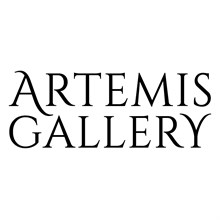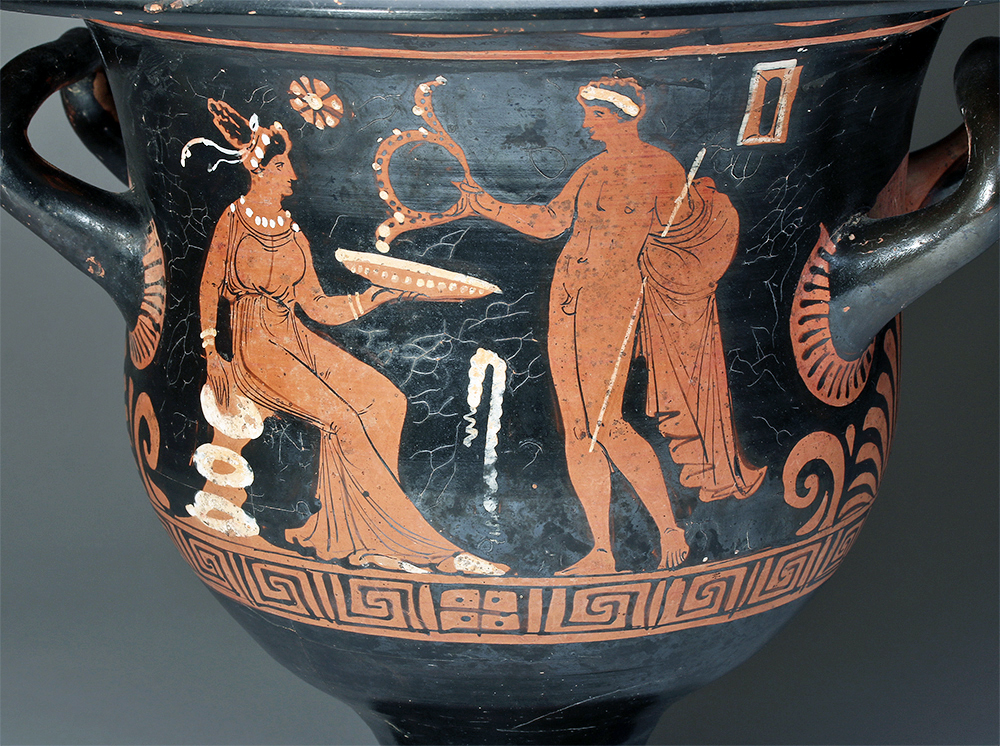35
Greek Apulian Red-Figure Bell Krater - Varrese Painter Magna Graecia, Southern Italy, Apulia, ca.
Description
Greek Apulian Red-Figure Bell Krater - Varrese Painter
Magna Graecia, Southern Italy, Apulia, ca. mid-4th century BCE. A very fine and large example of a Greek bell krater (mixing bowl) vessel, attributed to the Varrese Painter, one of the more significant painters of the mid-4th century. According to A.D. Trendall, "his work had a considerable influence not only on his immediate followers, but also on the forerunners of the Darius Painter." (A.D. Trendall, Red Figure Vases of South Italy and Sicily. New York: Thames and Hudson, 1989, p. 83.) Well composed of thick terracotta, slipped in black with red figures. This vessel depicts two scenes. Side A has a standing nude youth and a seated maiden, the young male presenting an offering to the lady. Side B depicts two men facing one another, both wrapped in tunics, with the oval-shaped 'signature' of the Varrese Painter between. Beneath handles are traditional palmette designs. On the underside of the rim, a continuous spray of laurel leaves. Beneath the figures a register decorated with a Greek key pattern. In the center of this register is one checkerboard and dot patterned panel that also indicates the piece is by the Varrese Painter. Size: 11-1/8" (28.26 cm) H x 12-3/8" (31.43 cm) in diameter.
The Apulian workshop emerged during the last thirty years of the 5th century BCE. At the beginning of the 4th century BCE, two distinct styles appeared: the Plain style and the Ornate style. This vase is halfway between the two, displaying characteristics of the Plain style (bell-krater, few highlights, iconographic tradition) and the Ornate style (large size, numerous figures, complex decoration).
Provenance: Ex-private Ketchum, Idaho collection, acquired at major auction houses and galleries before 2004.
All items legal to buy/sell under U.S. Statute covering cultural patrimony Code 2600, CHAPTER 14, and are guaranteed to be as described or your money back.
A Certificate of Authenticity will accompany all winning bids.
#108386
Condition
Slightly crazed surface with nice manganese inside the foot. Repaired from approximately 12 pieces. Overall excellent.
Magna Graecia, Southern Italy, Apulia, ca. mid-4th century BCE. A very fine and large example of a Greek bell krater (mixing bowl) vessel, attributed to the Varrese Painter, one of the more significant painters of the mid-4th century. According to A.D. Trendall, "his work had a considerable influence not only on his immediate followers, but also on the forerunners of the Darius Painter." (A.D. Trendall, Red Figure Vases of South Italy and Sicily. New York: Thames and Hudson, 1989, p. 83.) Well composed of thick terracotta, slipped in black with red figures. This vessel depicts two scenes. Side A has a standing nude youth and a seated maiden, the young male presenting an offering to the lady. Side B depicts two men facing one another, both wrapped in tunics, with the oval-shaped 'signature' of the Varrese Painter between. Beneath handles are traditional palmette designs. On the underside of the rim, a continuous spray of laurel leaves. Beneath the figures a register decorated with a Greek key pattern. In the center of this register is one checkerboard and dot patterned panel that also indicates the piece is by the Varrese Painter. Size: 11-1/8" (28.26 cm) H x 12-3/8" (31.43 cm) in diameter.
The Apulian workshop emerged during the last thirty years of the 5th century BCE. At the beginning of the 4th century BCE, two distinct styles appeared: the Plain style and the Ornate style. This vase is halfway between the two, displaying characteristics of the Plain style (bell-krater, few highlights, iconographic tradition) and the Ornate style (large size, numerous figures, complex decoration).
Provenance: Ex-private Ketchum, Idaho collection, acquired at major auction houses and galleries before 2004.
All items legal to buy/sell under U.S. Statute covering cultural patrimony Code 2600, CHAPTER 14, and are guaranteed to be as described or your money back.
A Certificate of Authenticity will accompany all winning bids.
#108386
Condition
Slightly crazed surface with nice manganese inside the foot. Repaired from approximately 12 pieces. Overall excellent.
Auction Details
Shipping
T&Cs & Important Info
Ask seller a question
Greek Apulian Red-Figure Bell Krater - Varrese Painter
Magna Graecia, Southern Italy, Apulia, ca. mid-4th century BCE. A very fine and large example of a Greek bell krater (mixing bowl) vessel, attributed to the Varrese Painter, one of the more significant painters of the mid-4th century. According to A.D. Trendall, "his work had a considerable influence not only on his immediate followers, but also on the forerunners of the Darius Painter." (A.D. Trendall, Red Figure Vases of South Italy and Sicily. New York: Thames and Hudson, 1989, p. 83.) Well composed of thick terracotta, slipped in black with red figures. This vessel depicts two scenes. Side A has a standing nude youth and a seated maiden, the young male presenting an offering to the lady. Side B depicts two men facing one another, both wrapped in tunics, with the oval-shaped 'signature' of the Varrese Painter between. Beneath handles are traditional palmette designs. On the underside of the rim, a continuous spray of laurel leaves. Beneath the figures a register decorated with a Greek key pattern. In the center of this register is one checkerboard and dot patterned panel that also indicates the piece is by the Varrese Painter. Size: 11-1/8" (28.26 cm) H x 12-3/8" (31.43 cm) in diameter.
The Apulian workshop emerged during the last thirty years of the 5th century BCE. At the beginning of the 4th century BCE, two distinct styles appeared: the Plain style and the Ornate style. This vase is halfway between the two, displaying characteristics of the Plain style (bell-krater, few highlights, iconographic tradition) and the Ornate style (large size, numerous figures, complex decoration).
Provenance: Ex-private Ketchum, Idaho collection, acquired at major auction houses and galleries before 2004.
All items legal to buy/sell under U.S. Statute covering cultural patrimony Code 2600, CHAPTER 14, and are guaranteed to be as described or your money back.
A Certificate of Authenticity will accompany all winning bids.
#108386
Condition
Slightly crazed surface with nice manganese inside the foot. Repaired from approximately 12 pieces. Overall excellent.
Magna Graecia, Southern Italy, Apulia, ca. mid-4th century BCE. A very fine and large example of a Greek bell krater (mixing bowl) vessel, attributed to the Varrese Painter, one of the more significant painters of the mid-4th century. According to A.D. Trendall, "his work had a considerable influence not only on his immediate followers, but also on the forerunners of the Darius Painter." (A.D. Trendall, Red Figure Vases of South Italy and Sicily. New York: Thames and Hudson, 1989, p. 83.) Well composed of thick terracotta, slipped in black with red figures. This vessel depicts two scenes. Side A has a standing nude youth and a seated maiden, the young male presenting an offering to the lady. Side B depicts two men facing one another, both wrapped in tunics, with the oval-shaped 'signature' of the Varrese Painter between. Beneath handles are traditional palmette designs. On the underside of the rim, a continuous spray of laurel leaves. Beneath the figures a register decorated with a Greek key pattern. In the center of this register is one checkerboard and dot patterned panel that also indicates the piece is by the Varrese Painter. Size: 11-1/8" (28.26 cm) H x 12-3/8" (31.43 cm) in diameter.
The Apulian workshop emerged during the last thirty years of the 5th century BCE. At the beginning of the 4th century BCE, two distinct styles appeared: the Plain style and the Ornate style. This vase is halfway between the two, displaying characteristics of the Plain style (bell-krater, few highlights, iconographic tradition) and the Ornate style (large size, numerous figures, complex decoration).
Provenance: Ex-private Ketchum, Idaho collection, acquired at major auction houses and galleries before 2004.
All items legal to buy/sell under U.S. Statute covering cultural patrimony Code 2600, CHAPTER 14, and are guaranteed to be as described or your money back.
A Certificate of Authenticity will accompany all winning bids.
#108386
Condition
Slightly crazed surface with nice manganese inside the foot. Repaired from approximately 12 pieces. Overall excellent.
Exceptional Ancient and Ethnographic Art
Sale Date(s)
Venue Address
P.O. BOX 714
Erie
Colorado
80516
United States
For Artemis Gallery LIVE delivery information please telephone +1 7205025289.
Important Information
Join us for an important one-day auction featuring museum-worthy examples of classical antiquities, ancient and ethnographic art from cultures encompassing the globe. Included are an incredible ancient Egyptian wooden box with translated panels, a rare 12th century 22+ karat pure gold Burmese Buddha. Egyptian, Greek, Roman, Etruscan, Near Eastern, Asian, Pre-Columbian, Native American, Spanish Colonial, Russian, even a 17th century Spanish Oil Painting! Don’t miss these truly important examples unlikely to come to market again!


